A History of Computing at Michigan Tech, Part III

Now in its third year, the College of Computing is on an upward trajectory. Student enrollment is up appreciably and other key indicators confirm that the upward trend will continue. In this three-part series, we take a close look at how we got here, what our college looks like today, and what we’re working to accomplish as we look to the future. Part I | Part II | Part III
Visit the History of Computing at Michigan Tech webpage.
Our Mission and Vision
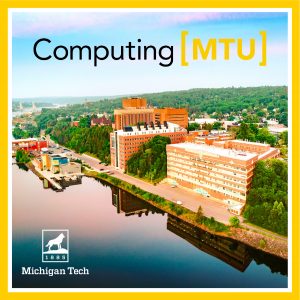
Mission: To advance the transformational promise of computing in the service of society through excellence in teaching, research, and outreach.
Vision: To be the premier provider of computing talent and innovation to Michigan and the Great Lakes region.
A World that Needs the College of Computing
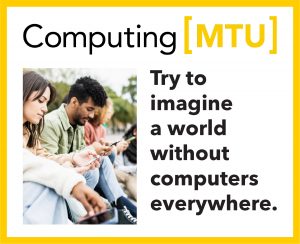
Try to imagine a world without computers everywhere…without smartphones, smart cars, connected appliances, streaming, and e-banking. For better or worse, the genie is out of the bottle and computing, connectivity, and artificial intelligence have become critically ingrained in nearly every aspect of modern life. This is not the world of the personal computer; this is the world that needs the College of Computing.
As we have already detailed in this series, computing at Michigan Tech long predates the formation of the college. However, its formation represents an important inflection point. Computing is not just the purview of techies and programmers. Rather, digital transformation has morphed every discipline into a computing discipline. Manufacturing, criminal justice, marketing, health care–none of which are traditionally computing disciplines–are all being reinvented by digital technologies. The College of Computing was formed to make sure that all of these disciplines, especially those in Michigan and the surrounding region, have the computing talent they need to thrive in this brave new world.
Maintaining the Momentum!
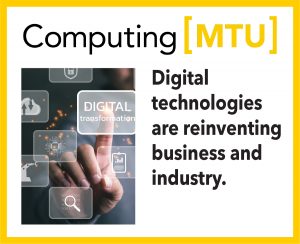
Our approach is twofold. We will continue to grow both our traditional programs in computer science and IT, as well as our newer convergence programs that connect computing to other disciplines, such as health informatics and mechatronics. There were a lot of impressive growth statistics mentioned in our last article, perhaps the most exciting is that five different programs increased enrollment more than 75% in the past year.
Yes, these programs are new and started small, but this hypergrowth clearly highlights that we are filling previously unmet needs. We will continue working with colleagues across Michigan Tech to support the digital transformation of traditionally non-computing domains. Simultaneously, our programs in computer science, software engineering, and IT are more relevant now than ever before, and they remain the cornerstone of our future efforts.
New Spaces to Promote Convergence
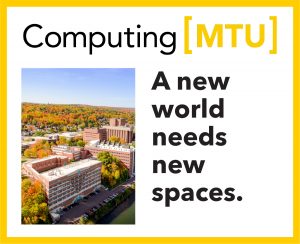
Perhaps the most exciting convergence is happening via our growing partnerships with the College of Business. Programs in data science and MIS (management information systems) have connected business and computing for some time, but we recently announced a deeper partnership to stay ahead of the digital transformation curve. While still some years away, we recently announced plans for a Center for Convergence and Innovation, a new building that will house both colleges.
The physical space represents a mixing bowl that will promote true and deep integration of our faculty, students, academic programs, and research spaces. Programs in areas like MIS, data science, fintech, and cybersecurity are the most obvious to benefit from partnership, but our hope is that it will also improve our core business and computing programs.
Institute of Computing and Cybersystems
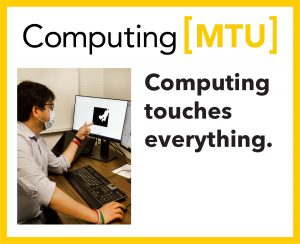
Another critical partner is the Institute of Computing and Cybersystems (ICC), the computing research arm of Michigan Tech. Obviously, College of Computing faculty are members, but there are actually even more members from outside of the college, again highlighting the ubiquity of computing and computing research. As such, the ICC represents the ideal vehicle to promote connections across disciplines both inside and outside of Michigan Tech.
While it is an emerging tier-1 research center at Michigan Tech, the ICC unfortunately does not have a physical home, which is one of the reasons we are rethinking all of our research spaces in the college. Going forward, our labs will be co-branded with the ICC and transformed into exciting collaborative spaces dedicated to the seven ICC research themes: (i.) biocomputing and digital health; (ii.) computing education; (iii.) cyber-physical systems; (iv.) cybersecurity; (v.) human-centered computing; (vi.) scalable architectures and systems; and (vii.) data science.
Data Science
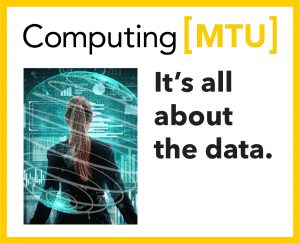
Speaking of data science, this is another major priority for the college. The ability to extract knowledge and insight from Big Data is driving digital transformation every bit as much as device miniaturization. From simple analytics to complex deep learning algorithms, data is only as good as the methods we have to understand it and make realistic predictions from.
Recognizing this, we recently created a new college executive team position to make sure that we continue to meet the talent needs of data science and seize opportunities to do things in new ways. Dr. Laura Brown, associate professor of computer science, is the inaugural Director of Data Science Initiatives, and has been tasked with accelerating our embrace of data science campuswide.
Dr. Brown will be promoting all elements of data science, not just the computing aspects, by working with colleagues from math, business, and other disciplines to create new programs, some of which are already underway. In particular, we will soon be exploring undergraduate degree opportunities in data science, and, consequently, new organizational structures will likely be needed if these programs take off as expected.
The Data Science MS program was created in 2015 as a partnership between math, business, and computing. The broad based curriculum includes data-science fundamentals, data mining, predictive analytics, communication, and business acumen.
Diversity, Equity, and Inclusion
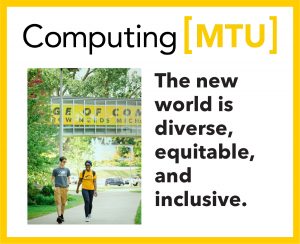
Talent is uniformly distributed, unfortunately opportunity is not. We are working hard to change that – every person who wants to be a computing professional should have the opportunity to do so. As such, promoting diversity, equity, and inclusion (DEI) are just as important to us as new buildings and interdisciplinary research. We are currently developing our first DEI strategic plan for the college, which will integrate ongoing efforts with new ones.
We do this because of the inherent value of diversity, equity, and inclusion, and because it leads to better outcomes. At our recent Innovators in Industry–The Computing Revolution webinar, the panelists provided several examples of when diverse teams came up with innovative solutions, whereas teams without diversity too frequently missed opportunities before them. We will support all computing students and continually advocate for diversity in tech because of this. And, because it’s the right thing to do.
Forward Together

Last spring I announced Forward Together, which is our collective effort to advance the college. This fall, five Forward Together working groups created plans to advance the college on topics ranging from our visual identity to student success. The groups had limited time to complete their sprints – only a couple of months – which they were able to do successfully. The outputs are not perfect and will need to evolve over time, but they substantially moved us forward.
We will continue this process of collaborative and intense focus on strategic needs every fall semester. Plans for next year are already being put together. That is to say, we can never become complacent. We will continue to identify challenges and opportunities, and this culture of continuous improvement will drive everything that we do.
Computing[MTU]
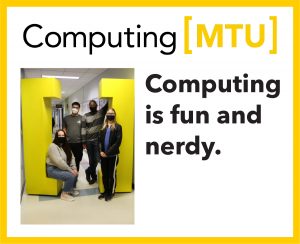
Speaking of visual identity, the university is rolling out a new official sub-brand logo for the college. Our new logo is meant to be both nerdy and fun. Computing[MTU] is a reference to subscription within programming an array. In computer languages like C, the elements within the brackets define the location, or index, within the array. So, in this case, the array called Computing refers to the universe of computing, and the index identifies computing at Michigan Tech. Like I said, nerdy…which we fully embrace.
Going forward, we intend to play with this metaphor and will feature the brackets heavily in social media and other visual media. In fact, we have recently constructed a pair of physical brackets that are more than 6-feet tall that we can use to frame our imagery – imagine taking a picture from atop Mount Ripley of our beautiful campus framed in the brackets. Moreover, we are also getting a smaller set of brackets to deploy as a selfie station for students and alumni. That is to say, Computing[MTU] is a holistic effort for us to engage with our community in both the physical and digital worlds, while also hardening our brand.
Tomorrow Needs Michigan Tech
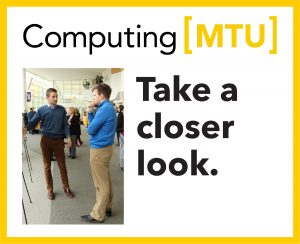
As you can see, we have a lot going on in the College of Computing as we position ourselves and our college to help Michigan Tech become “a premier national university positioned to lead the nation in the Fourth Industrial Revolution.” Thank you for reading and I encourage you to stay connected as we announce several additional efforts in the coming months.
This is the final installment of this three-part blog series on the College of Computing at Michigan Tech. Tomorrow Needs Michigan Tech. It’s more than a tagline. Instead, it’s our promise to continue to serve the needs of our students and state.